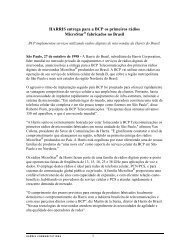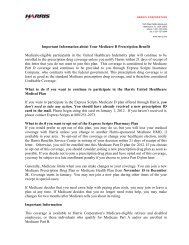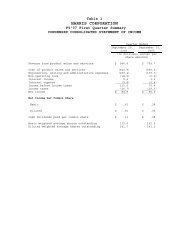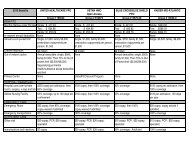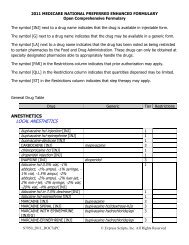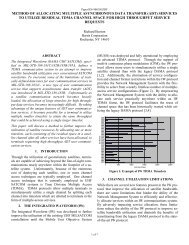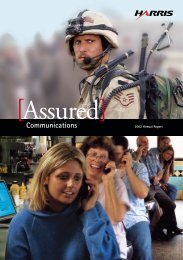harris corporation
harris corporation
harris corporation
You also want an ePaper? Increase the reach of your titles
YUMPU automatically turns print PDFs into web optimized ePapers that Google loves.
including risks relating to our U.S. Government contracts and subcontracts, see “Item 1. Business — Principal<br />
Customers; Government Contracts,” “Item 1A. Risk Factors” and “Item 3. Legal Proceedings” of this Report.<br />
Government Communications Systems<br />
Government Communications Systems conducts advanced research and produces, integrates and supports highly<br />
reliable, net-centric communications and information technology that solve the mission-critical challenges of our<br />
civilian, defense and intelligence government customers, primarily the U.S. Government, and is comprised of<br />
(i) Civil Programs, (ii) Defense Programs and (iii) National Intelligence Programs.<br />
Civil Programs: We provide highly reliable, mission-critical communications and information processing<br />
systems that meet the most demanding needs of customers in the U.S. civilian Federal market, including the Federal<br />
Aviation Administration (“FAA”) and the National Oceanic and Atmospheric Administration (“NOAA”). We use our<br />
ability to implement and manage large, complex programs that integrate secure, advanced communications and<br />
information processing technologies in order to improve productivity and information processing and to achieve cost<br />
savings for our customers. Our networks and information systems for large-scale, geographically dispersed<br />
enterprises offer advanced capabilities for collecting, processing, analyzing, interpreting, displaying, distributing,<br />
storing and retrieving data. We are a leader in satellite ground data processing and mission command-and-control<br />
(“C2”) systems. Our ground data processing systems consist of complex suites of hardware and software that receive<br />
sensor data from satellites, turning it into useable information. Our C2 systems feature COTS design and high levels<br />
of flexibility, are designed for government and commercial applications, and support single-satellite missions as well<br />
as some of the largest and most complex satellite fleets deployed.<br />
For example, we are the prime contractor and system architect under a 15-year contract awarded in July 2002,<br />
with a potential value of $3.5 billion, for the FTI program to integrate, modernize, operate and maintain the<br />
communications infrastructure for the U.S. air traffic control system. FTI is a modern, secure and efficient network<br />
providing voice, data and video communications deployed at more than 4,500 FAA sites across the United States to<br />
enhance network efficiency, reliability and security and to improve service while reducing operating costs. We<br />
designed and deployed the FTI network and it is fully operational. The FTI network consists of the Operations<br />
Network, the Mission Support Network, the Satellite Network and the Microwave Network. The supporting<br />
infrastructure includes the Network Operations Control Centers (“NOCCs”) and Security Operations Control Centers<br />
(“SOCCs”). The FTI program has completed its equipment build-out phase and is transitioning to its<br />
telecommunication services and maintenance phase.<br />
Other FAA programs under which we have developed solutions include the following:<br />
• The Operational and Supportability Implementation System (“OASIS”), for which we are the prime<br />
contractor and which provides integrated weather briefing and flight planning capabilities for preflight<br />
weather briefings and in-flight updates for Alaska’s general aviation community. In fiscal 2011, we were<br />
awarded a follow-on contract by the FAA to upgrade and manage the OASIS system;<br />
• The Weather and Radar Processor (“WARP”) system, a meteorological data processing system serving the<br />
en-route air traffic control environment that generates radar mosaic data for air traffic controller displays and<br />
delivers weather data to critical subsystems within the National Airspace System (“NAS”). In fiscal 2010, we<br />
were awarded a six-year contract, with a potential value of $97 million, by the FAA under the WARP<br />
Maintenance and Sustainment Services II program to continue to maintain the WARP system by providing<br />
hardware and software maintenance, depot support, on-site field support and engineering services at<br />
22 operational FAA facilities in the United States;<br />
• The Voice Switching and Control System (“VSCS”), which provides the critical air-to-ground<br />
communications links between en-route aircraft and air traffic controllers throughout the continental<br />
United States.; and<br />
• The satellite-based Alaskan NAS Interfacility Communications System (“ANICS”), which links the Alaskan<br />
Air Route Traffic Control Center in Anchorage with 64 FAA facilities throughout the region. After the close<br />
of fiscal 2011, we were selected as the prime contractor under the Alaska Satellite Telecommunications<br />
Infrastructure (“ASTI”) program for a 10-year contract, with a potential value of $85 million, from the FAA<br />
to upgrade the ANICS network by replacing and upgrading components and providing a new network<br />
management system, system security enhancements, logistics support and training in order to increase<br />
network performance and availability while reducing the FAA’s operating and maintenance costs.<br />
Another example of our capabilities relates to NOAA’s Geostationary Operational Environmental Satellite —<br />
Series R (“GOES-R”) Ground and Antenna Segment weather programs. Under two ten-year contracts, with an<br />
aggregate potential value of approximately $1 billion (including change orders), we are providing a complete,<br />
10




